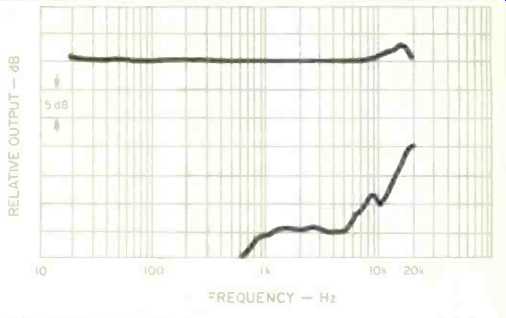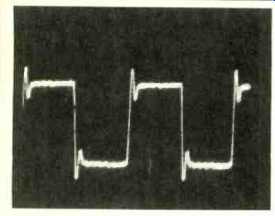
Manufacturer's Specifications:
Frequency Response: 10 to 28,000 Hz.
Sensitivity: 0.75 mV at 1 cm/S.
Channel Separation at 1 kHz: 30 dB.
Channel Separation at 10 kHz: 25 dB.
Channel Balance: 1 dB.
Frequency IM Distortion at -6 dB: 0.3%.
Impedance: 900 ohms.
Inductance: 170 mH.
Recommended Load: 47 kilohms and 470 pF.
Tracking Force Range: 1.0 to 1.5 grams.
Optimum Tracking Force: 1.25 grams.
Compliance (Static): 24 mm/N.
Tracking Ability: 300 Hz, 80 µm; 10.8 kHz, 0.6% distortion at 30 cm/S.
Effective Mass: <0.4 mg.
Diamond Mass: 0.015 mg.
Tip Radii: 5 x 18 µm, "Analog 6."
Weight: 3.5 grams.
Price: $250.00.
AKG, located in Vienna, Austria, is a world-renowned manufacturer of high-class professional microphones. A few years ago, AKG entered the phono cartridge market with the introduction of a line of stereo phono cartridges using their patented transversal suspension (TS) for the stylus cantilever. The current AKG stereo phono cartridge series includes the P25MD/24, the top-of-the-line cartridge, using an "improved" induced-magnet design and their previously used TS for the stylus cantilever. The cantilever is a rigid thin-wall tube made from an aluminum-magnesium silicon alloy that has both low mass and low resonance. To reduce the effective tip mass, AKG uses a micro-diamond (MD) stylus with a very short shank that is nude-mounted on the cantilever. The shape of the diamond stylus, called "Analog-6," appears to be another version of the well-known extended-line-contact type. The newly developed transducer system consists of a cylindrical samarium-cobalt magnet that encloses the four nickel-iron alloy pole pieces upon which the coils are mounted, thus increasing the basic sensitivity and permitting a reduction in coil inductance. The lightweight plastic housing is claimed to be free from resonances which would impair the sound. The housing is made from electrically conductive plastic material so as to provide a path to ground, thus preventing an electrostatic charge build-up on the cartridge body. The front of the molded plastic housing has a gold-colored arrowhead type point to indicate the stylus location for ease in cueing a record.
The AKG P25MD/24 stereo phono cartridge comes packed in handsome black vinyl case that also contains a stylus-cleaning brush, a screwdriver, the necessary mounting hardware, a wedge-shaped weight to be used with tonearms that will not balance a lightweight cartridge or as a wedge to raise the back of the cartridge (should it be too close to the record surface so as to scrape it), a flexible plastic damping compound to be inserted between the headshell and the cartridge, and a unique installation and alignment gauge. This useful gauge may be used to adjust the overhang, vertical alignment of stylus axis, azimuth, and vertical tracking angle; to secure the cartridge for both mounting in the headshell and attaching the headshell wires to the cartridge pins; to clean the stylus; to inspect the stylus for dirt with the supplied magnifying glass and, finally, as a balance to measure the stylus t racking force (1.0 to 1.5 grams). Each cartridge comes with a copy of its own frequency response and crosstalk curve. The installation manual as well as the operating instructions for the gauge are well written. I noted that some of the manufacturer's specifications in the instruction manual did not agree with those in the advertising brochure. The maker tells us that this has to do with the U.S. version, the, "/24," being slightly different from the European model, the "/34," which has its specs given in the installation manual.
Measurements
Note: Parts of this magazine article text was damaged and could not be properly transcribed. Missing content is denoted by [...]The AKG P25MD/24 stereo phono cartridge was mounted in a Technics headshell, and used with the Technics EPA 100 tonearm mounted on a Technics SP-10 Mk II turntable. The cartridge was oriented in the headshell and tonearm with the Dennesen Geometric Soundtracktor. When the flat bottom at the stylus end of the cartridge the record surface, warped records problem.
Laboratory tests were conducted at a. [...] ture of 68° F, ± 1° (20° C) and a relative [...] ±3%. The tracking force for all repo [...] ohms, and the load capacitance was 489 pF. The following test records were used in making the reported measurements: Columbia STR-170, STR-100, STR112; Shure TTR-103, TTR-109 TTR-110, TTR-115: Deutsches HiFi No. 2; JVC TRS-1007; Nippon Columbia XL-7004; the Ortofon Pickup Test Records 0001 and 0002.

Fig. 1--Frequency response and separation, AKG P25MD/24.

Fig. 2--Response to a 1-kHz square wave.
I have been measuring phono cartridge frequency response and separation (crosstalk) for many years. It has never been a very satisfactory measurement since it is wholly dependent cn the combination of the cartridge and the sweep-frequency record used for measuring these parameters. My usual practice is to use the Columbia STR-170 test record for this job. However, for certain cartridges the separation is worse when measured with the STR-170 than if some other test record were used, e.g., the JVC TRS1007. Since neither the cutting lathe, cutting stylus, phono cartridge, nor the test record is perfect, many factors come into play when a test record is used to measure the frequency response and separation of a given phono cartridge Whether the separation of the two stereo channels is 15 or 20 dB is not that important insofar as maintaining good stereo imagerly is concerned. Of course, separation greater than 15 dB,' e.g., 30 dB, will undoubtedly improve the stereo imagery, producing an audible difference that most people will hear. In my opinion, any audible crosstalk has an adverse effect upon the recorded sound we listen to. Accordingly, it appears to be most important that the [...] 3rtridge manufacturers strive to improve separation of their product to an even ponse of the AKG P25MD/24, using the [...] -ecord, is-0 dB, + 1 dB from 20 Hz to kHz, +2.5 dB at 15 kHz, +2.9 dB at [...] +1 dB from 40 Hz to 10 kHz, + 1.8 dB at 15 kHz, +2.25 dB at 17 kHz, and +1 dB at 20 kHz. Separation is 20.6 dB at 1 kHz, 20.8 dB at 10 kHz, 16.8 dB at 15 kHz, 13.6 dB at 17 kHz, and 10 dB at 20 kHz. From these data it is evident that the AKG P25MD/24 has an excellent frequency response and from an excellent to a very satisfactory high-frequency separation, depending on which test record is used to make the measurement. With both test records, the high frequency resonant point is at 17 kHz, probably due to the action of the stylus-tip mass with the compliance of the vinyl test records. This is supported by the square-wave response, where this resonance shows a medium overshoot followed by a low-level ringing at 17 kHz.
Using the Dynamic Sound Devices' Dynamic Mass Analyzer, DMA-1, the arm-cartridge dynamo mass was measured as 26 grams, and the dynamic vertical compliance is 13.4 x 10-6 cm/dyne at the vertical resonant frequency of 8.5 Hz at +2.3 dB amplitude. The arr, cartridge low-frequency lateral resonance is 8.5 Hz at +2 dB amplitude.
Although the AKG installation manual says that the P25/ MD weighs 3.5 grams, this is for the "/35" version; I found that the U.S. version, the "/24," weighs a good bit more 4.9 grams.
Wt., 4.9 g; d.c. res., 1,031 ohms; i d., 109 mH; opt. tracking force, 1.25 g; anti-skating force 1.7 g; output, 0.70 mV/cm/S; IM distortion: (4:1) +9 dB la eral, 200/4000 Hz, 1.0%; +6 dB vertical, 200/4000 Hz, 4.4%; crosstalk (using Shure TTR-109),-25 dB; channel balance, within 1.5 dB; trackability: high freq, (10.8 kHz, puls freq. (1000 and 1500 Hz, lat. cut), 31.5 and 4000 Hz, tat. cut), 24 cm/S; Deutsct [...] d), 30 cm/S; midm/S; low freq. (400 es Hi-Fi No. 2, 300 Hz test band was tracked only to 67 milcrons at the 1.25-g tracking force. Increasing the tracking force by 100 mg, to 1.35 g, the 300-Hz test band was tracked cleanly to 86 microns (0.0086 cm) lateral at 16.20 cm''^ ^-' 43.1 microns (0.00431 cm) vertical at 8 dB. It is a rare cartridge which can tr band.
The AKG P25MD/24 phono cartridge difficulty in playing all the test bands Obstacle Course-Era Ill musical test to indicate a possible loss of their clarity. There was no mistracking or intermodulation type of distortion at any time.
It is a rare cartridge that can truly negotiate all the high levels on these excellent musical test records, inasmuch as level 5 peak-recorded velocities for the combined instruments exceed 45 cm/S and 50 cm/S, respectively. As a point of reference, the peak-recorded velocity of commercial records rarely exceeds about 20 cm/S.
Use and Listening Tests
Listening tests were performed both before and after measurement, as is usual. The cartridge was put through the "wringer" in reproducing a wide variety of difficult records. The cartridge was able to cleanly reproduce The Sheffield Drum Record (Lab 14). However, unlike its predecessor (PEES), it was unable to negotiate the high velocities of the cannon shots present on the Tchaikovsky 1812 recording (Telarc DG-10041). While listening to the various records and, in particular, the Tchaikovsky Romeo & Juliet/ Nutcracker Suite, Maazel and Cleveland Orchestra (Telarc DG-10068), I noted an excellent sonic clarity, transparency of sound, and transient response, as well as the lack of detectable coloration, when reproducing the high recorded levels present on most direct-to-disc recordings. I did find the P25MD/24 to be a bit bright at high frequencies, par- [...] . any' ort piatlO nd string instruments, but this can be easily corrected with the treble tone controls. Voice was reproduced very ell, and applause definition was excellent. The P25MD/24 performed very well when playing dbx-encoded records, such as The Digital Fiedler, Arthur Fiedler and the Boston Plops (Ultragroove Records UG-7003), where the absence truly evaluate the d intended lob-repro uncolored manner.
In conclusion, the new AKG phono ca an excellent choice P25MD/24, the top-of-the-line of the cartridge series, should be considered as for most every music system.
-B. V. Pisha
Addendum
Shortly after I had mailed this Equipment Profile to the Editor, I received another P25MD/24 for review, an "improved" version of the one tested. The new P25MD/24 has "an epoxy addled to the wax compound that is used to hold the pole pieces in place. This prevents them and the coils from resonating at higher frequencies." led( of some of the parameters anding was pretty much the same except the frequency response curve and the were improved. The high-end frequency [...] + 1.25 dB at 10 kHz, + 1.5 dB at 15 7 kHz, and 0 dB at 20 kHz. Separation [...]
(Source: Audio magazine; Aug. 1982)
Also see:
AKG P8ES Stereo Cartridge (Equip. Profile, Dec. 1978)
JVC Model QL-7 Direct-Drive Turntable (Dec. 1978)
Shure V15 Type V Phono Cartridge (Nov. 1982)
Signet TK10ML moving-magnet phono cartridge (Feb. 1985)
= = = =